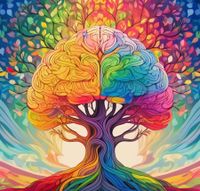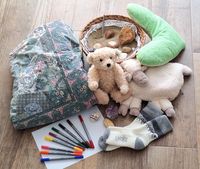Visual and Tactile Support for Anxiety and Worries
I am your Comfort Keeper🧘, the guardian of well-being, and in this section, I provide resource-rich content to help you better manage stress and anxiety.
Visual Support
In crisis situations, it's important for people to feel as safe and calm as possible, and images are a great choice for this. Show images that can create a peaceful and calming atmosphere. Natural landscapes and abstract artworks can be helpful in crisis situations as they calm the mind and reduce stress. Natural landscapes are something people around the world know and love. They can convey a sense of familiarity and security. Images that create a peaceful atmosphere can help foster emotional stability and reduce feelings of panic. They provide a visual calm zone that can soothe the mind. Soft colors and gentle shapes in abstract art can help calm attention and relax the mind. They divert attention from immediate danger and offer a visual escape. These images are often culturally neutral and can therefore be equally appreciated by people of many different backgrounds.
Trees are always a wonderful motif, as they symbolize strength, rootedness, and life itself. They stand for permanence and growth, which can be especially calming in times of crisis. A combination of fresh spring foliage, the first tender leaves, and vibrant, radiant autumn leaves can create a particularly harmonious and calming atmosphere, as it also symbolizes the idea of progress and the continuation of life. It shows that despite the challenges and changes that life brings, new beginnings and growth are always possible. A variety of colors and textures can also convey hope and confidence by symbolizing the different seasons and perpetual growth. This combination not only creates a harmonious and calming atmosphere of rootedness and growth but also shows that life is constantly changing and that each phase has its own value. This diversity can give people in times of crisis hope and optimism by reminding them of the constancy and eternal cycle of life.
1. Forest clearings with clear streams: These images offer a peaceful and natural environment, representing both rootedness and movement.
2. Trees along the banks of a lake or river: These images combine the strength of trees with the tranquility of water and can create a harmonious atmosphere.
3. Gentle hills and valleys with trees: These landscapes provide a peaceful and calm environment, conveying familiarity and security.
4. Forests with calm rivers or lakes: This combination offers the strength and stability of trees as well as the calming effect of water.
5. Autumn forests with warm, golden colors: Trees with vibrant, radiant autumn leaves symbolizing warmth and strength.
6. Spring meadows with blooming flowers: Fresh, vibrant colors and plants representing new beginnings and hope.
7. Springtime forests with the first tender leaves: The first tender leaves and buds symbolizing slow yet steady growth.
8. Autumn forests with warm, reddish colors: Trees with vibrant, reddish leaves symbolizing warmth and steadfastness.
A crucial aspect not to be underestimated: Tactile Support
I have assembled a variety of materials and tools for you that help calm and reduce anxiety
- Fleece or flannel blankets: Offer a soft and pleasant texture. The warmth provided by fleece or flannel blankets can have a calming and comforting effect, especially in stressful situations. Wrapping oneself in a soft, cozy blanket can convey a sense of security and safety, similar to a hug.
- Comfort blankets: Special soft blankets often used for babies and toddlers. They combine the soothing properties of stuffed animals with the functionality of a comfort blanket. Many comfort blankets have cute animal motifs like bunnies, bears, or elephants, with their heads or paws poking out of the blanket, creating a wonderful combination of stuffed animal and blanket. Comfort blankets often take on the scent of parents or home, which can provide an additional feeling of security in a shelter. They offer a sense of safety and comfort, especially in stressful or unfamiliar situations.
How about this?
Bunny comfort blanket: A soft blanket with a cute bunny head and long ears, perfect for snuggling and comfort.
Bear comfort blanket: A cuddly blanket with a bear head, serving as both a little companion and a cuddle toy.
Elephant comfort blanket: A soft blanket with an elephant head and short arms, providing a pleasant touch and calming effect.
Star comfort blanket: A star-shaped blanket with various textures and materials, stimulating the sense of touch.
- Plush cushions: Super soft and cozy, or cotton cushions with various patterns that offer different tactile stimuli. Plush cushions provide a soft, cuddly surface that feels pleasant on the skin and immediately conveys a sense of comfort and safety. Plush cushions can serve as comforters and provide a sense of security and safety, similar to a stuffed animal. Many people associate plush cushions with positive memories and feelings from childhood, which can be additionally soothing. They can also serve as extra padding to feel more comfortable in uncomfortable situations.
- Therapy blankets with weights and different textures, also known as weighted blankets or sensory blankets, offer multiple benefits and calming effects. Weighted pressure (Deep Touch Pressure)—that is, the weight of the blanket applies gentle, even pressure on the body. This resembles a hug and can calm the nervous system by stimulating the production of serotonin and melatonin, leading to a feeling of safety and relaxation. The deep pressure helps reduce feelings of anxiety and stress, which can be particularly helpful in stressful situations such as disaster alarms. These blankets are also used in occupational therapy and for treating autism, ADHD, and sensory processing disorders to help individuals calm and relax. Blankets with different textures provide tactile stimulation, which can be soothing. The various surfaces offer a sensory experience that helps distract from anxious thoughts and convey a calming feeling. For people who have difficulty with sensory processing, the different textures can help better process sensory information and promote a sense of well-being.
A weighted blanket could look like this
- Material: High-quality cotton or microfiber for comfort and breathability
- Weight: Varies depending on the user's needs, typically between 2 kg and 10 kg
- Filling: Non-toxic glass beads or plastic pellets, sewn evenly into the blanket to distribute the weight
- Textures: Combination of smooth, soft, and textured materials to offer a versatile tactile experience
- Stress balls/tactile balls in different sizes are wonderful tactile aids to reduce anxiety and provide sensory stimulation. Holding and squeezing tactile balls can help relieve tension and stress. They provide a wonderful way to channel nervous energy and distract attention from anxious thoughts.
- Magic cubes: Solving a magic cube requires concentration and focus. This can help divert attention from anxious thoughts and focus on a positive challenge. The cube promotes analytical thinking and the ability to solve problems step by step. Turning and manipulating the cube offers tactile stimulation, which can be calming. The feeling of control over the cube's movement can also be soothing. In a shelter, solving magic cubes together can become a communal activity. People can give each other tips and collaborate to solve the cube.
- Stuffed animals: Many people associate stuffed animals with positive memories and feelings from childhood, which can provide an additional sense of security. Stuffed animals can offer an emotional connection that helps to feel less lonely and anxious. They are easy to carry and can be on hand in any situation, whether at home, on the go, or in a shelter.
- Shells: Shells have a natural, organic texture that can be calming and grounding. The sight and feel of shells can evoke positive associations with nature and the sea, which can be soothing. Listening to and feeling the shells can serve as a mindfulness exercise to focus on the moment and reduce anxiety. A small box with different shells can serve as a sensory box. People can touch the shells and explore their various textures and shapes. Such a box can be calming in stressful situations and provide distraction. When you rub shells together or move them, they produce gentle, soothing sounds that can mimic the sound of the ocean.
How about these?
Cockle shells: Small, smooth shells with a soft texture and pleasant grip.
Snail shells: Spirally shaped shells with interesting textures and patterns.
Scallop shells: Larger shells with a ridged surface, offering an interesting tactile experience.
Clam shells: Round, flat shells with various colors and patterns that are pleasant to hold.
- Soothing woods or stones (hand soothers): Woods and stones are easy to carry and can be kept in a pocket or backpack. Woods are natural, organic materials that offer a pleasant texture, such as wooden hearts, wooden balls, wooden discs, or wooden animals. Hand soother stones are usually smooth and polished, offering a pleasant tactile experience. Stroking and rubbing woods and stones can have a calming effect and help relieve tension. Hand soothers can serve as a focal point for mindfulness exercises to focus on the present moment and reduce anxiety. Combine holding a hand soother with deep breathing exercises to achieve a relaxing effect.
- Hand massage balls: Hand massage balls are a great tool for reducing anxiety and calming the hands in stressful situations. They provide not only tactile stimulation but also help relieve tension. Kneading and pressing the balls can help relieve tension and stress and serve as an outlet for nervous energy.
- Hand warmers: They provide not only physical warmth but also a calming and comforting effect. Hand warmers are small and easy to carry, making them ideal for use on the go or in emergency situations.
- Modelling clay: Modelling clay, also known as plastiline or plasticine, is a versatile and soothing tool that can be useful for both children and adults, especially in stressful situations like in shelters. Modelling clay allows for creative shaping and forming, which can help to alleviate stress and distract from anxious circumstances. The physical act of kneading and pressing the clay can ease tension and serve as an outlet for nervous energy. In shelters, individuals can work together on clay projects, strengthening a sense of community and preventing isolation.
- Sand: Sand can surprisingly serve as a soothing tool to reduce anxiety and stress. The feel and play with sand offer a calming tactile stimulus that can help ease tension. A small box or tray of sand can act as a sensory box. People can feel, scoop, and mould the sand to calm and relax themselves. Such a box can be calming in stressful situations and provide a distraction. Sand play can also help people with sensory processing disorders to better process sensory information.
- Ergonomic neck supports: These supports provide comfort and support for the neck and can help reduce tension.
- Small hand mirrors: A small hand mirror can be used to ground oneself by looking at one's own face and taking deep breaths to calm down.
- Games and puzzles: Games and puzzles offer a positive mental distraction and help shift thoughts away from anxious situations.
- Bracelets made of calming stones: These bracelets are made of calming stones such as amethyst or rose quartz and can be worn constantly to achieve a soothing effect. Touching and playing with the stones can have a calming effect.
- Compression gloves: These gloves provide gentle pressure and support for the hands, which can be soothing and comforting. They promote blood circulation and can help alleviate tension.
- Noise-cancelling headphones: These headphones block ambient noise and can help create a quiet environment, which is especially helpful in noisy shelters. They can be used with calming music or nature sounds to promote relaxation.
- Glass marbles: Glass marbles have a smooth, cool surface that is pleasant to touch and can have a calming effect. The shine and transparency of glass marbles can be fascinating and soothing. A small box with different glass marbles can serve as a tactile box. People can feel the marbles, roll them, and explore their various textures and colors. People can use glass marbles to create creative patterns or pictures, which can be a calming and creative activity. Classic marble games can be played to pass the time and provide a positive distraction.
- Mini whiteboards and markers: Drawing on a small whiteboard can be a soothing and distracting activity.
- Comfort socks: Socks made from soft materials like fleece or wool blends provide comfort and warmth, which can have a calming effect. Putting on and wearing comfort socks can be a small ritual of self-care.
- Finger puppets: Finger puppets can be used to perform small plays or tell stories, which can be both calming and distracting. They can help promote dialogue and interaction between people. Playing with finger puppets allows individuals to focus on something positive and creative, which can help reduce anxiety and stress. Well-known fairy tales and stories can be reenacted with finger puppets, providing a familiar and soothing activity. Finger puppets can serve as icebreakers, helping to break down barriers, especially in stressful or tense situations. All participants can actively engage, fostering a sense of community and preventing isolation. Finger puppets can be used to moderate group discussions, ensuring that every participant has the opportunity to express their thoughts and feelings. They can be utilized in role-playing scenarios to collaboratively find solutions for problems that may arise in shelters. Finger puppets are small and easy to transport, making them ideal for use in shelters. Additionally, they are usually inexpensive and can be easily procured in large quantities.
- Coloring books for all ages (colored pencils): Coloring pictures can have a calming effect and help people focus on a pleasant activity. Coloring books provide a positive distraction and promote creative expression.
- Calming pebbles: Calming pebbles have a smooth, cool surface that feels pleasant in the hand. Touching and holding these stones can have a soothing effect and help release tension. Individuals can hold a single calming pebble in their hand and use it to calm themselves. Stroking and turning the pebble can help reduce stress and create a calm atmosphere. In stressful situations, the deliberate feeling of the pebble can help to calm the mind and focus on the moment. People can share their experiences with calming pebbles and support each other, fostering dialogue and a sense of community. In shelters, guided mindfulness sessions can be held using calming pebbles to help direct focus and promote relaxation.
Jasper: A soothing stone with earthy colors and natural patterns that can provide a sense of grounding.
Rose quartz: A pink stone known for its calming and comforting properties.
Agate: A stone with interesting patterns and colors that can be visually appealing and soothing.
Crystal quartz: A clear, transparent stone with a smooth, cool surface that can have a calming effect.
- Calming cards: Calming cards are wonderful tools for promoting a positive mindset and practicing mindfulness. These cards contain positive affirmations or soothing messages that can help foster a positive outlook. Examples of such affirmations could include, “I am strong and brave,” “I find peace in the here and now,” or “I trust in my abilities.” Regularly reading and repeating positive affirmations can help reduce anxiety and boost self-confidence. Looking at and reading the cards helps to calm the mind and focus on the present moment. This can be particularly helpful in stressful situations. Calming cards are small and easy to carry, making them ideal for use in shelters or on the go.
- Puzzles: Solving puzzles requires concentration and patience. This helps divert focus from anxious thoughts and concentrate on a positive challenge. Puzzles with 100-200 pieces that are quick and easy to solve provide a fast, calming activity. Solving a puzzle together fosters collaboration and a sense of community. People can work together to complete the picture, strengthening social bonds. Solving puzzles in groups requires communication and teamwork, which can help promote social interaction and prevent isolation.
- Hand fan: A small hand fan can help provide cool air, contributing to relaxation, especially in hot or stuffy environments. The quiet hum of the fan can offer a soothing background noise.
- Small notebook or journal: A notebook can be used to write down thoughts and feelings, which can have a calming effect. It can also be used for creative writing or recording positive memories, boosting confidence in a positive future.
- Origami sets: Folding paper requires concentration and precision, which helps distract the mind from anxious thoughts. Origami offers a creative challenge, allowing various shapes and figures to be formed. This promotes a positive and constructive activity. Origami paper is lightweight and compact, making it easy to store in emergency kits or bags and take out when needed. Origami requires no special tools or materials other than the paper itself, making it a straightforward activity. Individuals can focus on folding to calm themselves and reduce anxiety. The repetitive actions and the resulting shape can be very soothing. Group "Origami sessions" can strengthen the sense of community and promote collaboration and bonding among participants. People can assist each other and share new techniques.
Examples of simple origami figures
Crane: A classic origami model known for its symbolic meaning of peace.
- Square paper: Start with a square sheet of paper with the colored side facing down.
- Diagonal fold: Fold the paper diagonally to form a triangle, and then unfold it. Repeat this for the other diagonal.
- Halve: Fold the paper in half to form a rectangle, and then unfold it. Repeat this for the other direction.
- Base shape: Bring the diagonal and horizontal folds together to form a diamond shape (also known as the "waterbomb base").
- Fold side corners: Fold the side corners to the center, forming a kite shape.
- Fold the top corner: Fold the top corner down over the newly formed edges. Unfold the folds.
- Inside reverse folds: Open up the bottom point and fold it upwards, causing the sides to collapse into a long, thin kite shape.
- Form the wings: Fold the lower tips of both sides upwards to form the wings.
- Head and tail: Fold one tip down to form the head. Gently pull the wings down to spread them out.
Butterfly: A simple yet beautiful figure that is colorful and decorative.
- Square paper: Start with a square sheet of paper.
- Diagonal fold: Fold the paper diagonally in both directions, then unfold it.
- Rectangular fold: Fold the paper in half (top to bottom), then unfold it.
- Mountain and valley: Hold the opposite edges and push them to the center to form a smaller square (triangle).
- Corners to the center: Fold the right and left corners to the center creating a smaller triangle.
- Forming the wings: Turn the model over and fold the top point down. Fold the lower edges up to the midline.
- Butterfly shape: Fold the model in half and shape the butterfly by gently pulling the wings apart.
Frog: A fun and simple model that can even jump when lightly pressed.
- Square paper: Start with a square sheet of paper.
- Diagonal fold: Fold the paper diagonally in both directions, then unfold it.
- Rectangular fold: Fold the paper in half (top to bottom), then unfold it.
- Form a smaller square: Bring the diagonal folds together to create a smaller square (diamond shape).
- Fold the legs: Fold the lower corners to the center to form the legs.
- Lift the legs: Fold the lower edges up so the frog stands.
- Spring mechanism: Fold the lower edges upwards, then fold them back down to the center to activate the jumping function.
Flowers: Various flower shapes that are easy to fold and can serve as beautiful decorations.
Lily
- Square Paper: Start with a square sheet of paper.
- Diagonal Fold: Fold the paper diagonally in both directions and open it again.
- Square Shape: Bring the diagonal folds together to form a smaller square.
- Sides to Center: Fold the side corners to the center.
- Edges to Center: Fold the new side edges to the center.
- Fold Upper Corner: Fold the upper tip down.
- Inside Fold: Open the bottom tip and fold it upwards.
- Shape Petals: Gently pull the edges outwards and fold them back to shape the petals.
Best regards, your Comfort Keeper🧘, and don't forget to check out the "Musik" section.
This contribution was written by Birgit Bortoluzzi, the creative founder of the “University of Hope” – an independent knowledge platform with a mission: to make resilience, education, and compassion visible and audible in a complex world.



